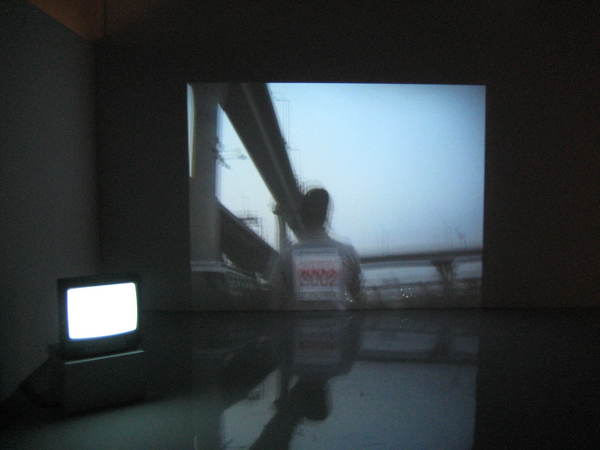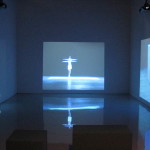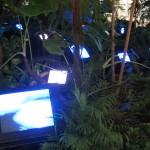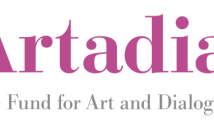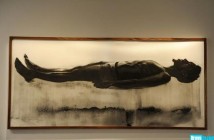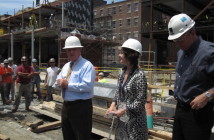I have spent the last two issues discussing the work that I viewed in Beijing, so I figured it was time to talk a little bit about my trip to Seoul. A lot of the work in galleries the Korean capital was fairly traditional - paintings, sculpture, fabric – but there were a couple of instances of new media work.
The Arko Art Center, a space dedicated to contemporary Korean art, was one of my first stops after recovering from jetlag. It was a little hard to find as it is located off the drag road behind a park, but I wandered around a little bit and finally found it after I spotted an installation of televisions surrounding a fountain. (They weren’t on or doing anything, but as there was a festival of some kind being set up, I imagine that they were part of that event and not really related to the exhibition I was there to check out.)
The center was hosting a show titled “Video: Vide & O,” curated by Ahn Kyung Hwa. The title stems from the one of the pieces in the exhibition by Kim Soun-gui that utilizes the semiotics of the term video, breaking it down to its French components: vide (empty) and eau (water). According to the artist, “video represents an empty vase, which also has the potential to shine bright if used well.” The video itself (created in 1989) however, felt much more like a testament of the time in which it was created. It was more of a performance-based document than a stand-alone video piece as we think of works in video today. This is the moment that I realized that the exhibition was really a survey of Korean video work, which actually excited me. This is work that rarely makes it to Boston.
One of the strongest pieces in the exhibit was Jung Sanghyun’s I Suggest a Tour of the Gallery, the artist created in 2003. At first the work seems like a fairly simple projection involving a diorama of a gallery, however, it turns out to be a constructed set of a gallery with a small doorway at the far end. Jung uses the set as a camera and the image through the doorway is of an exhibition of famous international artists (the exhibition and the art is actually unrecognizable). What I found interesting was the notion of re-framing the art. The fact that we were seeing what he found or thought was interesting in this other exhibition. I had a moment where I wished I had information on this other show but ultimately let it go and enjoyed the piece for what it was: an active re-imagining of an artistic experience.
Another one I quite liked was Gu Minja’s 42.195 from 2006. In this work, executed with a large projection and a monitor sitting on the floor, the artist upends the concept of a marathon by slowing it down. She performs the marathon but outside of the actual race, and she does it alone and in silence over the course of two days. According to the curator, the artist’s act of performing the marathon “portrays the continuance of time.” I’m not sure I completely agree. There are times when it is reducible to time passing but one has to conceptualize because the reality is, no one can actually watch it in its entirety. You have to imagine that the time is passing because you’re certainly not going to sit in the gallery and watch it play out over two days. Perhaps one way to get this point is to watch the larger projection (of the artist walking the race) in contrast to the video on the small monitor, which is frenetically edited and involves many people running the race. The two videos are clearly in conversation with each other, but somehow the connection felt forced to me. Was the idea that if we didn’t get what the projection was about, then all we had to do was watch the other video? It felt a little obvious. I preferred to just watch the projection.
Farther into the gallery was a three channel projection installation by Nam Hwayeon titled Delusion Beach (for B. Jackson) from 2008. The installation was quite stunning with the video reflected off of the floors of the gallery. Apparently the artist was using the three projections as X, Y, and Z coordinates that mark the location of the “place” i.e. “delusion beach.” Within each video, dancers perform and act as if their bodies are points on a compass. It was all very visually interesting, yet I felt that the point really wasn’t coming across.
My other video moment was a trip to the Nam June Paik Art Center. This was quite an overwhelming experience. One cannot talk about video art and not mention the influence of Paik. If I was going to be in Korea, I was willing to endure the schlep from Seoul. The forty minute bus ride to Gyeonggi Province took longer as I missed my stop, adding over two hours to the trek, but it was well worth it. The center opened in 2008, and exhibits a permanent collection of the pioneering electronic artist’s work. The visit was not only a journey through the history of video art but also lead me deep into the history of Fluxus. I’m sure a lot of this has to do with the nature of the collection. One cannot exhibit Paik’s work without speaking to the Fluxus movement. It was literally a walk through the every moment of Paik’s art making. The Paik/Abe synthesizer is installed and running in one of the galleries alongside the very first robot that Paik created in 1964. There was also a great deal of his later work, created upon his return to Korea; one interesting installation was the complete contents of his workshop. Much like the re-created studio of Frances Bacon at his retrospective in New York, the “workshop” gives special insight to the mindset of a man who spent the majority of his life tinkering with technology. I left the center sated, but really excited by the possibilities inherent in technological art. I often have moments when there doesn’t seem to be anything exciting taking place in the sphere of tech art, and this was a great experience to have. I saw both the historical and the contemporary, and it resided in a country and a city that is on the cutting edge of media technology. The experience both validated and consummated my decision to start my journey across Asia in Seoul.
- Gu Minja, 42.195, Video, 2006.
- Nam Hwayeon, Delusion Beach (for B. Jackson), HD Video, 2008.
- Nam June Paik, TV Garden, Video, Installed in 2008.
Arko Art Center (Arts Council Korea Site)
All images are courtesy of the artist and venue specified.

